The language of the dead – How to read a graveyard. Things to look out for and what they mean.
Graveyards and cemeteries have their own language and there’s more to the symbolism than just the standard cross. Certain symbols and figures are an important feature of graves that can tell you more about the deceased than just their name and their date of birth and death. Some symbols have remained eternally popular while others come and go in and out of fashion like everything else.
There can be many different meanings to each symbol and this is in no way a definitive collection and we have also added our own thoughts of what each symbol might mean. Hopefully, this page will work as a dictionary of death that will help in deciphering and decoding graves and will be constantly updated as we find different features on our travels.
We would also love to hear any definitions that you have come across so please let us know by using the contact page.



Anchor: not only to indicate that the deceased was a seaman or sailor, but it can also symbolise the anchoring influence of Christ. It is a symbol of steadfastness and safety and can almost be viewed as a crucifix in disguise. Anchors are often shown with a broken chain – a life no longer anchored to the Earth.
Angels: a common sight in all graveyards and cemeteries. Angels are heavenly messengers of God that guide a soul, after death, to Heaven. Angels are often depicted in different poses; weeping, praying, pointing to Heaven. Their faces are often different, believed to be a portrait of the deceased.
Apple: representing the original sin it can also mean salvation.
Arrow: a symbol of martyrdom. Arrows are used as weapons so might grace the grave of someone who was involved in the military.
Bell: used in many cultures as a call to worship the bell is a highly religious symbol. Associated with the expression “saved by the bell”, bells were sometimes attached to a corpse with the idea that if they were just in a coma and buried alive they could ring the bell and be saved. Probably by a shocked gravedigger!


Bluebell: often referred to as ‘Dead Man’s Bells’ they are commonly found in wooded areas and many overgrown cemeteries and graveyards. Associated with the fairy realm they are sometimes found on the graves of children.




Book: symbolising the Book of Life or The Bible. Having the book lying open represents the deceased’s heart is open to God. Now the deceased’s life story has ended his or her deeds can be recorded and remembered. Simply, it might indicate that the departed was an author, scholar, librarian or bookseller. A book is a symbol of knowledge.
Chain: depicting the link of the soul to the body and therefore its link to Earth. Broken chains can mean a life cut short. Sometimes used as a nautical symbol.
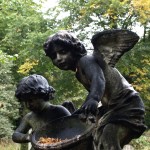
Cherubs: usually used to designate the grave of a child, the cherub signifies innocence and purity.
Clock: much like the hourglass it depicts our time on Earth and life.
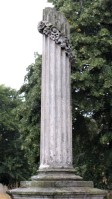
Column: a classic symbol and one frequently found in Victorian cemeteries. a full column signifies a noble life and will sometimes be accompanied by an urn on the top.
Broken column: a life cut short, someone who died young or suddenly.
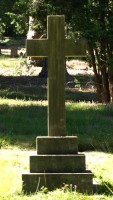



Cross: probably the most well-recognised symbol found in burial sites all over the world. The cross represents Christianity and salvation. Crosses come in many shapes and forms.
Often the initials I.H.S will be found in the centre of a cross. This is often mistaken for a dollar sign, these letters are the monogram of the letters that form Jesus’ name in the Greek alphabet: Iota, Eta and Sigma.
Celtic/Irish: a cross within a circle, it represents the eternity of the soul. The intricate knot work is never ending and symbolises how life and eternity are interconnected.
Eastern Orthodox: distinctive due to its extra ‘arms’ which represents Christ’s crucifixion.
Roofed: often found on roadsides in Orthodox countries, this is to protect them from the elements which symbolise the protection of God. The roof also illustrates a new ‘home’ for the soul in Heaven.



Crown: often associated with royalty, it can also be a symbol of Christ and victory over death.


Daisy: innocence, often found on the graves of young women and children.

Dog: symbolises friendship and loyalty. Often the dog depicted is one the deceased owned in life.


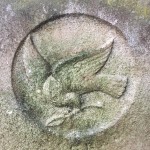
Dove: a Christian symbol for the Holy Spirit. It also symbolises purity, love and peace. Often pictured with an olive branch in its beak. Dove’s are frequently found on the graves of women who have died young. A common symbol in cemeteries it represents the soul and its ‘flight’ to Heaven.


Fern: humility, and sincerity.
Fish: associated with Christ and his feeding of the 5,000 and the “miracle of the five loaves and two fish”. Can denote the grave of a fisherman.
Fleur de Lis: representing the Holy Trinity.

Flowers: a popular symbol in graveyards, flowers are associated with death and funerals. A universal symbol that covers all faiths and cultures.



Gates/Doors: commonly a Christian symbolism representing the passageway from Earth to Heaven as the soul makes its final journey. An opening into a new space or higher plane of enlightenment. In John 10:9, Jesus is quoted as saying, “I am the gate. Whoever enters through me will be saved”. Also reminiscent of a Holy Door, found in Roman Catholic churches, which if a person passes through will have all of their sins forgiven.


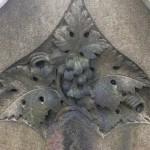
Grapes: can represent the wine of communion and the ‘Blood of Christ’.


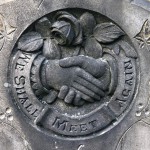
Hands: a symbol that takes many forms and is very common in Victoria cemeteries. It is a depiction of the departed’s relationships on Earth.
With a pointing finger: the finger pointing upwards symbolises the soul travelling to Heaven or the hope of Heaven. A finger pointing downwards might seem like it’s pointing to Hell but represents the hand of God guiding the soul to Heaven or symbolising a divine message.
Hands clasping: these are very common on the graves of couples. Representing love, friendship and loyalty. One can often tell if the persons interred were a married couple as one of the hands can display a shirt cuff to depict the husband. It can also symbolise the shaking of hands – the final farewell.
Praying/Blessing: religious devotion.
Reaching: the hand of God from Heaven.



Harp/Lyre: frequently mentioned in the Bible harps are often associated with angels and the heavens. Can sometimes signify Irish connections or musical talent.
Horseshoe: a common symbol for protection, horseshoes are seen as a good luck charm and are often hung over doorways to keep out evil spirits. Made from iron, a material traditionally used to ward off spirits, they are often held in place with seven nails, seven being the luckiest number.



Hourglass: reminds us that life is short and the sands of time are trickling away. It is often depicted with wings meaning that “time flies” and that death comes too soon for many of us.



IHS: often found in the centre of a cross. This is often mistaken for a dollar sign, these letters are the monogram of the letters that form Jesus’ name in the Greek alphabet: Iota, Eta and Sigma.



Ivy & Vines: denotes strength, immortality and regeneration. It is also a sign of friendship.


Knot: typically found on Celtic graves, tied knots are traditionally a symbol of unity and marriage and indicate resurrection and life everlasting. The intricate knot work is never ending and symbolises how life and eternity are interconnected.

Lamb: this figure is commonly found on the graves of children. It symbolises innocence and purity and is a reference to the lamb of God.


Lily: a traditional funeral flower it symbolises purity and virginity so it will often be found on the headstones of young women.
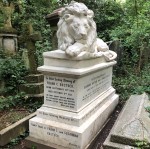

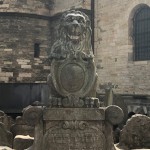
Lion: usually found protecting the entrances of tombs or mausoleums. Representing courage, power and strength, lions will often be found on top of the graves or tombs of soldiers and generals. Common in Jewish cemeteries

Masks: usually found on the graves of those in the performing arts. Comedy/Tragedy masks are a common symbol that dates back to Ancient Greece and could also be translated as happy in life, sad in death.

Oak leaves & acorns: the mighty oak tree symbolises strength and longevity. Oaks are very slow growing trees and it can take over 50 years for an oak to reach full maturity. With this in mind an oak tree at a family home may seen several generations come and go. Oak leaves on a grave may denote a long standing member of a family who lived a long life.

Obelisk: Common in many Victorian Cemeteries as the Victorians were obsessed with Classical imagery and Egyptian motifs. An obelisk is an Egyptian symbol for eternal life. Due to its pointed top, it almost points to heaven, which is why the symbol is easily converted as a Christian symbol.
Palm frond: victory and triumph over death. Also a symbol of peace and eternal life. A palm tree is often associated with paradise. A popular symbol in Victorian cemeteries.


Passion Flower: a common sight in many Victorian graveyards and cemeteries which has a very strong meaning in Christianity and is probably one of the most religious flowers depicted on headstone. The pointed tips of the leaves were taken to represent the Holy Lance. The tendrils represent the whips used in the flagellation of Christ. The ten petals and sepals represent the ten faithful apostles (less St. Peter the denier and Judas Iscariot the betrayer). The flower’s radial filaments, which can number more than a hundred and vary from flower to flower, represent the crown of thorns. The chalice-shaped ovary with its receptacle represents a hammer or the Holy Grail. The 3 stigmata represent the 3 nails and the 5 anthers below them the 5 wounds (four by the nails and one by the lance). The blue and white colours of many species’ flowers represent Heaven and Purity.
Pineapple: a sign of welcome. In the 17th Century were highly prized and used to welcome guests or given to a host of a party.

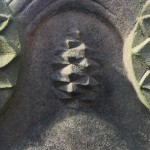
Pinecone: used as decoration in funerary art it is a symbol of immortality due
The Romans associated the pinecone with the goddess of fertility, Aphrodite. Also a symbolic representation of Human Enlightenment, pine trees are one of the most ancient plants on the planet


Poppy: another flower symbol that has many different meanings depending on the grave it is depicted on. Found on the graves of soldiers, especially those who perished in WWI due to the connotations with Flanders Fields. Often paired with ears of corn as the flower often grows in fields of wheat. It is often attributed to Christ’s Passion due to the blood red colour of the flowers petals. Because of the narcotic properties of the opium poppy it is also associated with sleep and death.


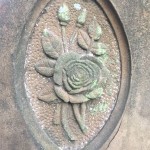
Rose: frequently adorns the graves of women, the rose symbolises love, beauty, virginity, purity and everlasting love. Depending on the rose’s status can indicate how old the person was at the time of death. A rose in bud will normally refer to a child under 12, a rose partially in bloom; a teenager, a rose in full bloom; the deceased died in the prime of their life so mid-twenties. A rose with a broken stem will symbolise a life cut short.
Scales: likely to mark the grave of a member of the law profession it is a symbol of justice. In the Bible the archangel Michael weighed the souls of the departed. Might also mark the grave of someone who was the zodiacal sign Libra.


Scroll: much like a symbol of a book, a scroll can symbolise the Book of Life or the recording of the deceased’s life story. A Symbol of life and time, rolled up can mean a life that is unfolding or was cut short. It is also symbol of knowledge.


Shell: often found on the top of headstones it is a symbol of birth and resurrection. It is a symbol of a pilgrimage and journey and originates from medieval times when priests would take pilgrimages to shrines, to prove that they had completed the journey, a shell would be collected from the beach nearby. Shells are often used to sprinkle water from during a baptism.


Ship: notably on the graves of sailors or mariners and commonly found in grave sites near water. It can also symbolise the journey the departed soul will take to Heaven.
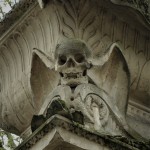

Skull: it might look like a morbid symbol but it is meant as a Memento Mori; a reminder of mortality. Skulls on headstones can take many forms.
Winged Skull: represents the fleetingness of life and the soul’s journey into the afterlife.
Skull and Crossbones: a common misconception is that it denotes the grave of a pirate. Nor is there any truth that it appears on the graves of Freemasons. It is believed that the Knights Templar used the symbol of the flags of their ships. The Order Knights of Pythias (an organisation similar to the Masons) have a skull and crossbones on their emblem and it can sometimes be found on the graves of members.
the skull and crossbones are another form of Memento Mori; death comes for us all. The symbol was often used to mark entrances to cemeteries and graveyards.

Snake: often teamed with a flame this indicates the Christian belief in the afterlife. When depicted in the form of Ouroboros (a snake eating its own tail) it represents eternal life, immortality and rejuvenation.


Star: depending on their orientation stars can have different meanings. A single star can represent Jesus, divine guidance or the guiding star of Bethlehem.
Star of David: a six pointed is the star, each point represents the 6 attributes of God: power, majesty, love, wisdom, mercy and justice.

Sun: representing God it is a symbol of light and warmth and life everlasting. A setting sun can represent death, and a rising sun, resurrection.
Sunflower: the flowers turn towards the sun which could represent a sunny disposition of the deceased. In Victorian flower language the sunflower is a flower of good luck and gratitude.
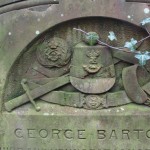
Sword: could probably represent a person who was in the military. The archangel Michael is portrayed with a sword, as are a number of saints (because so many were beheaded by one!) so the sword is often a symbol of Christianity.



Square & Compass: a common Masonic symbol that stands for faith and reason. Both are architect’s tools and are used in Masonic rituals as emblems to teach lessons. The square represents the ability to use teachings in ones own life. The compass is a symbol of self control and boundaries. Often pictured with a letter G, this often refers to God or geometry.
Thistle: often seen on Scottish graves or indicates a connection to Scotland. As the thistle is a thorny plant it also has connections with the Passion of Christ and the crown on thorns.

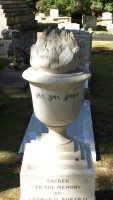

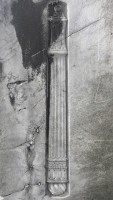
Torch/Flame: a symbol of death as well as eternal life and that the soul is still alight in the afterlife. Sometimes depicted upside down, an inverted torch can mean a life snuffed out, perhaps too early. In Medieval times it was used to drive away evil spirits.
Tree: a common theme in cemeteries and that symbolise strength and protection. It is commonly found on the graves of those who have been the head of a family. A symbol of the brevity of human life; the tree of life, it can also relate to the Family Tree. Often names of other family members are written on the branches with broken ones indicating other deceased relatives. Depicted as a stump, much like the broken column, it symbolises a life cut short.
The tree can also indicate that the deceased liked to work with wood, maybe they had a job as a carpenter.

Tulip: a symbol of love and passion.



Urn: an extremely common sight in Victorian cemeteries. It was probably appropriated from classical Roman symbols of cremation. It is a symbol of death and is often depicted draped with a cloth. This harks back to the days when a body was laid out in the parlour of the home and everything was draped in black. The drape symbolises the divide between life and death, a veil between Heaven and Earth. This is also known as the shroud of the soul.
Wheat: signifies life that has been “cut down” or “harvested” by a reaper (death) when it has reached its time. It could also be interpreted as bread, the symbol of the body of Christ. It also symbolises the cycle of the seasons and the cycle of life.
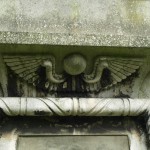

Winged disk: an ancient Egyptian symbol which represents the sun god Ra. Symbolising the life giving power of the sun and the heavens, the Victorians were obsessed with Egyptian motifs and they are often found on mausoleums and tombs.
Wreaths: another symbol of eternal life. As a circle, it has no beginning and no end. The wreath is a common sight on the graves of victims of war. The poppy wreath being synonymous with Remembrance Day. Traditionally laurel is used to make funeral wreaths. This evergreen plant keeps its green leaves for many seasons and is used to symbolise eternity and victory over death.